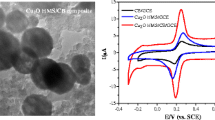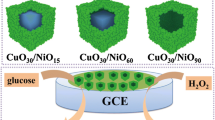Abstract
An amperometric nonenzymatic dopamine sensor has been developed. Cobalt oxide (Co3O4) nanoparticles were uniformly dispersed inside mesoporous SiO2/C. A sol-gel process was used for the preparation of this mesoporous composite material (SiO2/C). This mesoporous composite has a pore size of around 13–14 nm, a large surface area (SBET 421 m2·g−1) and large pore volume (0.98 cm3·g−1) as determined by the BET technique. The material compactness was confirmed by SEM images which showing that there is no phase segregation at the magnification applied. The chemical homogeneity of the materials was confirmed by EDX mapping. The SiO2/C/Co3O4 nanomaterial was pressed in desk format to fabricate a working electrode for nonenzymatic amperometric sensing of dopamine at a pH value of 7.0 and at a typical working potential of 0.25 V vs SCE. The detection limit, linear response range and sensitivity are 0.018 μmol L−1, 10–240 μmol L−1, and 80 μA·μmol L−1 cm−2, respectively. The response timé of the electrode is less than 1 s in the presence of 60 μmol L−1 of dopamine. The sensor showed chemically stability, high sensitivity and is not interfered by other electroactive molecules present in blood. The repeatability of this sensor was evaluated as 1.9% (RSD; for n = 10 at a 40 μmol L−1 dopamine level.

Schematic presentation of the preparation of a nanostructured composite of type SiO2/C/Co3O4 for electrooxidative sensing of dopamine.










Similar content being viewed by others
References
Sun Y, Lin Y, Ding C, Sun W, Dai Y, Zhu X, Liu H, Luo C (2018) An ultrasensitive and ultraselective chemiluminescence aptasensor for dopamine detection based on aptamers modified magnetic mesoporous silica @ graphite oxide polymers. Sensors Actuators B Chem 257:312–323. https://doi.org/10.1016/j.snb.2017.10.171
Farzin L, Shamsipur M, Samandari L, Sheibani S (2018) Advances in the design of nanomaterial-based electrochemical affinity and enzymatic biosensors for metabolic biomarkers: a review. Mikrochimica Acta 185(5):276. https://doi.org/10.1007/s00604-018-2820-8
Sáenz HSC, Hernández-Saravia LP, Selva JSG, Sukeri A, Espinoza-Montero PJ, Bertotti M (2018) Electrochemical dopamine sensor using a nanoporous gold microelectrode: a proof-of-concept study for the detection of dopamine release by scanning electrochemical microscopy. Microchim Acta 185(8):367. https://doi.org/10.1007/s00604-018-2898-z
Tang J, Jiang S, Liu Y, Shengbiao Z, Bai L, Guo J, Wang J (2018) Electrochemical determination of dopamine and uric acid using a glassy carbon electrode modified with a composite consisting of a co(II)-based metalorganic framework (ZIF-67) and graphene oxide. Microchim Acta 185(185):486–496. https://doi.org/10.1007/s00604-018-3025-x
Chen D, Tian C, Li X, Li Z, Han Z, Zhai C, Quan Y, Cui R, Zhang G (2018) Electrochemical determination of dopamine using a glassy carbon electrode modified with a nanocomposite consisting of nanoporous platinum-yttrium and graphene. Microchim Acta 185(2):98. https://doi.org/10.1007/s00604-017-2624-2
Anjali Devi JS, Anulekshmi AH, Salini S, Aparna RS, George S (2017) Boronic acid functionalized nitrogen doped carbon dots for fluorescent turn-on detection of dopamine. Microchim Acta 184(10):4081–4090. https://doi.org/10.1007/s00604-017-2433-7
Wang B, Chen M-M, Zhang H-Q, Wen W, Zhang X-H, Wang S-F (2017) A simple and sensitive fluorometric dopamine assay based on silica-coated CdTe quantum dots. Microchim Acta 184(9):3189–3196. https://doi.org/10.1007/s00604-017-2270-8
Shervedani RK, Bagherzadeh M (2008) Electrochemical characterization of in situ functionalized gold Cysteamine self-assembled monolayer with 4-Formylphenylboronic acid for detection of dopamine. Electroanalysis 20(5):550–557. https://doi.org/10.1002/elan.200704096
Lin L, Qiu P, Yang L, Cao X, Jin L (2006) Determination of dopamine in rat striatum by microdialysis and high-performance liquid chromatography with electrochemical detection on a functionalized multi-wall carbon nanotube electrode. Anal Bioanal Chem 384(6):1308–1313. https://doi.org/10.1007/s00216-005-0275-3
Liao J-L, Chi Y, Su Y-D, Huang H-X, Chang C-H, Liu S-H, Lee G-H, Chou P-T (2014) Os(ii) metal phosphors bearing tridentate 2,6-di(pyrazol-3-yl)pyridine chelate: synthetic design, characterization and application in OLED fabrication. J Mater Chem C 2(31):6269. https://doi.org/10.1039/c4tc00865k
Song X, Fu J, Wang J, Li C, Liu Z (2018) Simultaneous voltammetric determination of acetaminophen and dopamine using a glassy carbon electrode modified with copper porphyrin-exfoliated graphene. Mikrochimica Acta 185(8):369. https://doi.org/10.1007/s00604-018-2891-6
Zhuang X, Chen D, Zhang S, Luan F, Chen L (2018) Reduced graphene oxide functionalized with a CoS2/ionic liquid composite and decorated with gold nanoparticles for voltammetric sensing of dopamine. Microchim Acta 185(3):166. https://doi.org/10.1007/s00604-018-2712-y
Nasir M, Nawaz MH, Latif U, Yaqub M, Hayat A, Rahim A (2017) An overview on enzyme-mimicking nanomaterials for use in electrochemical and optical assays. Microchim Acta 184(2):323–342. https://doi.org/10.1007/s00604-016-2036-8
Dai H, Chen D, Li Y, Cao P, Wang N, Lin M (2018) Voltammetric sensing of dopamine based on a nanoneedle array consisting of NiCo2S4 hollow core-shells on a nickel foam. Microchim Acta 185(3):157. https://doi.org/10.1007/s00604-018-2718-5
Li Y, Jiang Y, Song Y, Li Y, Li S (2018) Simultaneous determination of dopamine and uric acid in the presence of ascorbic acid using a gold electrode modified with carboxylated graphene and silver nanocube functionalized polydopamine nanospheres. Microchim Acta 185(8):382. https://doi.org/10.1007/s00604-018-2922-3
Fattakhova Rohlfing D, Rathouský J, Rohlfing Y, Bartels O, Wark M (2005) Functionalized mesoporous silica films as a matrix for anchoring electrochemically active guests. Langmuir 21(24):11320–11329
Thenmozhi K, Narayanan SS (2007) Surface renewable sol–gel composite electrode derived from 3-aminopropyl trimethoxy silane with covalently immobilized thionin. Biosens Bioelectron 23(5):606–612
Cincotto FH, Canevari TC, Campos AM, Landers R, Machado SA (2014) Simultaneous determination of epinephrine and dopamine by electrochemical reduction on the hybrid material SiO(2)/graphene oxide decorated with Ag nanoparticles. Analyst 139(18):4634–4640. https://doi.org/10.1039/c4an00580e
Arguello J, Magosso HA, Landers R, Pimentel VL, Gushikem Y (2010) Synthesis, characterization and electroanalytical application of a new SiO2/SnO2 carbon ceramic electrode. Electrochim Acta 56(1):340–345. https://doi.org/10.1016/j.electacta.2010.08.073
Salimi A, Pourbeyram S (2003) Renewable sol–gel carbon ceramic electrodes modified with a Ru-complex for the amperometric detection of l-cysteine and glutathione. Talanta 60(1):205–214. https://doi.org/10.1016/S0039-9140(03)00125-5
Yuan Y, Wang P, Zhu G (2002) Sol-gel derived carbon ceramic electrode containing methylene blue-intercalated α-zirconium phosphate micro particles. Anal Bioanal Chem 372(5):712–717. https://doi.org/10.1007/s00216-001-1224-4
Rahim A, Rehman ZU, Mir S, Muhammad N, Rehman F, Nawaz MH, Yaqub M, Siddiqi SA, Chaudhry AA (2017) A non-enzymatic glucose sensor based on CuO-nanostructure modified carbon ceramic electrode. J Mol Liq 248:425–431
Pillay J, Ozoemena KI (2009) Layer-by-layer self-assembled nanostructured phthalocyaninatoiron(II)/SWCNT-poly(m-aminobenzenesulfonic acid) hybrid system on gold surface: Electron transfer dynamics and amplification of H2O2 response. Electrochim Acta 54(22):5053–5059. https://doi.org/10.1016/j.electacta.2008.12.056
Santos LS, Landers R, Gushikem Y (2011) Application of manganese (II) phthalocyanine synthesized in situ in the SiO2/SnO2 mixed oxide matrix for determination of dissolved oxygen by electrochemical techniques. Talanta 85(2):1213–1216. https://doi.org/10.1016/j.talanta.2011.06.003
Rahim A, Barros SBA, Arenas LT, Gushikem Y (2011) In situ immobilization of cobalt phthalocyanine on the mesoporous carbon ceramic SiO2/C prepared by the sol–gel process. Evaluation as an electrochemical sensor for oxalic acid. Electrochim Acta 56(3):1256–1261. https://doi.org/10.1016/j.electacta.2010.11.009
Khalid B, Rahim A, Gilani MA, Muhammad N, Younus AR, Tabassum S, Iqbal J, Alharthi AI (2018) In situ immobilization of CuO on SiO2/graphite matrix, modified with benzimidazolium-1-acatate ionic liquid: application as catechol sensor. J Mol Liq 251:450–457
Zagal JH, Griveau S, Ozoemena KI, Nyokong T, Bedioui F (2009) Carbon nanotubes, phthalocyanines and porphyrins: attractive hybrid materials for electrocatalysis and electroanalysis. J Nanosci Nanotechnol 9(4):2201–2214
Ozoemena KI, Nkosi D, Pillay J (2008) Influence of solution pH on the electron transport of the self-assembled nanoarrays of single-walled carbon nanotube-cobalt tetra-aminophthalocyanine on gold electrodes: Electrocatalytic detection of epinephrine. Electrochim Acta 53(6):2844–2851. https://doi.org/10.1016/j.electacta.2007.10.076
Ozoemena K, Nyokong T (2002) Octabutylthiophthalocyaninatoiron(ii): electrochemical properties and interaction with cyanide. J Chem Soc Dalton Trans (8):1806–1811. https://doi.org/10.1039/B111429H
Shen Y, Sheng Q, Zheng J (2017) A high-performance electrochemical dopamine sensor based on a platinum–nickel bimetallic decorated poly(dopamine)-functionalized reduced graphene oxide nanocomposite. Anal Methods 9(31):4566–4573. https://doi.org/10.1039/C7AY00717E
Tootoonchi A, Davarani SSH, Sedghi R, Shaabani A, Moazami HR (2018) A non-enzymatic biosensor based on Pd decorated reduced graphene oxide poly (2-anilinoethanol) nanocomposite and its application for the determination of dopamine. J Electrochem Soc 165(3):B150–B159
Hsieh Y-S, Hong B-D, Lee C-L (2016) Non-enzymatic sensing of dopamine using a glassy carbon electrode modified with a nanocomposite consisting of palladium nanocubes supported on reduced graphene oxide in a nafion matrix. Microchim Acta 183(2):905–910
Zhao C, Li J, Chen W, Yang Y, Chiang K, Burke N (2015) Synthesis and electrochemical properties of ordered mesoporous carbon supported well-dispersed cobalt oxide nanoparticles for supercapacitor. Mater Res Bull 64:55–60. https://doi.org/10.1016/j.materresbull.2014.12.047
Sing KS (1985) Reporting physisorption data for gas/solid systems with special reference to the determination of surface area and porosity (recommendations 1984). Pure Appl Chem 57(4):603–619
Wang X, Liu E, Zhang X (2014) Non-enzymatic glucose biosensor based on copper oxide-reduced graphene oxide nanocomposites synthesized from water-isopropanol solution. Electrochim Acta 130:253–260. https://doi.org/10.1016/j.electacta.2014.03.030
Palanisamy S, Ku S, Chen S-M (2013) Dopamine sensor based on a glassy carbon electrode modified with a reduced graphene oxide and palladium nanoparticles composite. Microchim Acta 180(11):1037–1042. https://doi.org/10.1007/s00604-013-1028-1
Zheng Y, Huang Z, Zhao C, Weng S, Zheng W, Lin X (2013) A gold electrode with a flower-like gold nanostructure for simultaneous determination of dopamine and ascorbic acid. Microchim Acta 180(7):537–544. https://doi.org/10.1007/s00604-013-0964-0
Yao Z, Yang X, Niu Y, Wu F, Hu Y, Yang Y (2017) Voltammetric dopamine sensor based on a gold electrode modified with reduced graphene oxide and Mn3O4 on gold nanoparticles. Microchim Acta 184(7):2081–2088. https://doi.org/10.1007/s00604-017-2210-7
Acknowledgements
Dr. Rahim is highly obliged to Higher Education Commission (HEC), Pakistan for the financial support under the SRGP Project No. 1106 and Ministry of Science and Technology of Pakistan for providing financial support in lab establishments.
Author information
Authors and Affiliations
Corresponding author
Ethics declarations
The author(s) declare that they have no competing interests.
Additional information
Publisher’s note
Springer Nature remains neutral with regard to jurisdictional claims in published maps and institutional affiliations.
Rights and permissions
About this article
Cite this article
Younus, A.R., Iqbal, J., Muhammad, N. et al. Nonenzymatic amperometric dopamine sensor based on a carbon ceramic electrode of type SiO2/C modified with Co3O4 nanoparticles. Microchim Acta 186, 471 (2019). https://doi.org/10.1007/s00604-019-3605-4
Received:
Accepted:
Published:
DOI: https://doi.org/10.1007/s00604-019-3605-4




